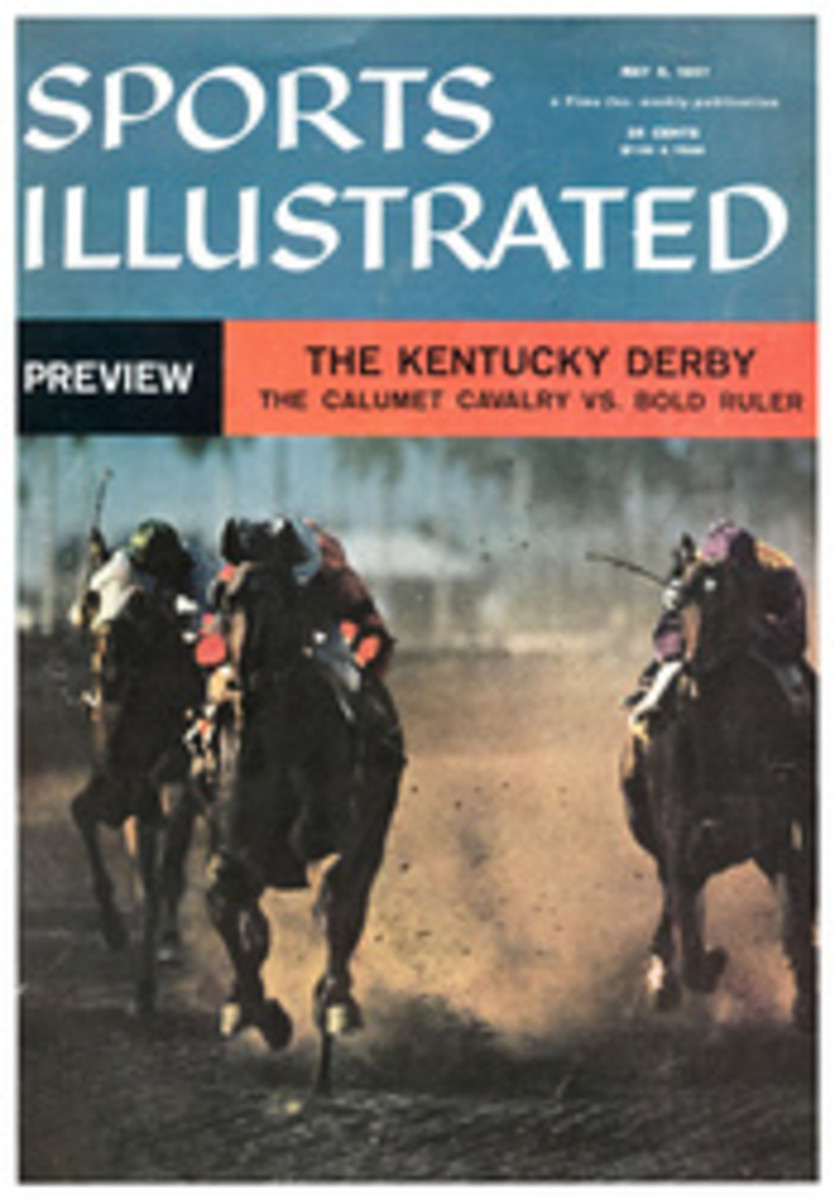
YOU SHOULD KNOW...
As thousands of gentlemen, scholars and judges of good whisky gather in Louisville this Derby week, most of the talk will be about horses, and practically all of it will be over a drink. Traditionally, the drink will be bourbon whisky, one of 30 different kinds of whisky recognized by the federal government, which closely regulates the whisky business. It is called bourbon after Bourbon County, Kentucky, where a lot of it has been distilled and ingested since D. Boone kilt a bar in the vicinity.
Bluegrass monument
Most visitors to the Derby will count that day lost on which they don't consume at least one mint julep. This concoction is doubly renowned—first for its ability to soothe the human soul and, second, for the inability of any two native-born Americans to agree on its proper construction. And despite a querulous clique of embittered imbibers of Scotch and blended whiskies who mutter that the drink is a desperate invention designed to hide the taste of bourbon and thus make it drinkable, the mint julep continues to stand as a mouth-watering monument to the genius of the Bluegrass State.
A proper mint julep
Despite all the argument, there is only one way to make a proper mint julep:
Take a dipper of water from a limestone spring and dissolve enough granulated sugar in it to give it a fine, oily texture, then set it aside. Take a goblet of sterling silver (or, in an emergency, a tumbler of cut crystal) and a single medium-sized leaf of mint, selected for succulent tenderness and plucked from the living plant not more than 10 minutes before. Using the back of a sterling silver spoon, bruise the leaf gently yet purposefully against the inside of the goblet and heap full of fairly fine-cracked ice made from limestone spring water. Pour straight bourbon whisky slowly into the goblet, letting it trickle through the ice at its leisure, until the vessel is almost full. After this has set for one minute, add the sugared water until the goblet threatens to overflow. Garnish the rim of the goblet with three sprigs of freshly picked mint. Do not stir. Let stand in a cool springhouse, or in a refrigerator, until the frosting on the goblet or tumbler is 3/32nds of an inch in thickness. Sip slowly, but don't use a straw. Between sips, think of a loved one.
Formula for whisky
Basically, say Uncle Sam's legal experts, whisky is "an alcoholic distillate from a fermented mash of grain distilled at less than 190 proof in such a manner that the distillate possesses the taste, aroma and characteristics generally attributed to whisky," and reduced by the addition of distilled water to not less than 80 proof before bottling. In other words, if it doesn't taste like whisky, it isn't whisky; also, it must be at least 40% alcohol. (The percentage of alcohol in any liquor is exactly one half the proof number; 200 proof would be pure alcohol.)
Proof of the bourbon
Ethyl alcohol boils at 172° Fahrenheit, water boils at 212°. If you make a mash of cracked grain mixed with water and let it ferment, the starch in the grain will turn into sugar and the sugar, in turn, will be transformed into alcohol. If you put the mash in a still and heat it to, say, 200°, the alcohol will boil off and can be condensed and collected, but hardly any of the water will come with it. The lower the temperature at which you boil off the alcohol, the less water there will be in the end product, and the higher the proof. A skillful distiller can regulate the proof of the liquor coming out of the still by regulating the heat he applies to the mash. When he wants more water and lower proof, he throws another log on the fire. (This is over-simple, but who isn't?)
Those neutral spirits
If the liquor comes from the still at 190 proof or more, it isn't legally whisky but something called "grain neutral spirits," which is light, relatively tasteless and an important ingredient of blended whisky, which can legally be made with up to 80% of grain neutral spirits. It's fashionable in some circles to disparage grain neutral spirits; these same circles usually support the market for vodka, which is simply g.n.s. diluted with water to reduce the proof.
Water and character
All whisky comes from the still at a higher proof than is practical for drinking purposes; to make it potable, the distiller adds distilled water. The only difference between 86 proof whisky and 90 or 100 proof whisky may be the amount of water that was added before bottling—and the price. But whisky that comes from the still at a low proof—say 150—will have more "body" and "character" than whisky distilled at a higher proof.
The "character" of a whisky is determined by the amount and variety of aldehydes, esters and other complex chemical compounds (including fusel oil in minuscule amounts) that are distilled along with ethyl alcohol and water; without these elements whisky would be flavorless and insipid. But since most of these compounds are also toxic, a "hearty" or "rich" or "robust" whisky is more likely to give you an enlarged head than a "light" (and less tasty) whisky.
Corn and charred oak
Bourbon whisky is legally distinguished from other types by the fact that the mash from which it is made is at least 51% corn (the remainder being wheat, rye or barley), that it is distilled at less than 160 proof, and is stored in new charred-oak barrels.
If bourbon whisky is also labeled "straight" (as it almost always is), it has been aged for not less than two full years in new charred-oak barrels; the exact age is printed somewhere on the label, as required by law.
When it comes from the still, whisky is almost as colorless as water; during aging it acquires color from the charred wood in which it is stored, and sometimes a coloring element may be added by the distiller (a smidgen of caramelized sugar gives a richer hue to the whisky without impairing the natural flavor).
How it began
During the American colonial period, grain was easy to grow in fertile soil, but transportation was difficult. If a farmer sent his corn or rye or barley by wagon to a distant market it might be hijacked by road agents, burnt by hostile Indians, dumped by a broken axle, ruined by mildew or made worthless by a glut on the market. In any event, it was bulky, perishable and expensive to store or ship. If he prudently converted the same amount of grain into whisky it was considerably smaller in bulk, easier and less expensive to ship, and it actually improved with age when stored for several years. Hence the abundance of distilleries in such outposts of civilization as Pennsylvania and Kentucky, the respective birthplaces of those marvelous inventions, rye and bourbon whisky.
Salt fish and whisky
The use of charred barrels for aging whisky is supposed to have originated in colonial times. Nobody knows for sure how the practice started, but one story has it that the only available barrels were those in which salt fish had been shipped to the whisky-making areas. To dispel the fish taste the insides of the barrel were charred, and by the time the settlers had learned to make barrels that would hold whisky without leaking, the custom of charring was established. (In any case, when the barrel is charred it's less likely to impart a woody flavor to the whisky.)
Bourbon and branch
Throughout the South, smaller tributaries of rivers are called branches—whence the expression "bourbon and branch" for bourbon and water. Bourbon (or any other whisky) is likely to leave the drinker with fewer regrets if it is drunk with plain or carbonated water, or (if taken neat) followed by a chaser.
The real corn
Contrary to popular notion, bourbon whisky and corn whisky are not the same thing. Straight corn whisky is made from a mash of at least 80% corn, and may be aged in uncharred re-used barrels.
Mellow with age
Whisky experts generally agree that a rich, heavy whisky requires longer aging than a lighter-bodied variety (which may be fully mature at four years), but no one is sure why aging makes whisky smoother and mellower, and no one has yet found a substitute for time in the making of whisky.
A little left-over mash
The sour-mash process of making bourbon whisky involves adding a portion of residue from a previous batch of mash to help start fermentation of a new batch; the process is slower and costlier, but a number of bourbon fanciers are convinced it's worth it, and cheerfully pony up the difference in price.
The good and the bad
In the folklore of whisky there are a number of ways to distinguish a "good" whisky from a "bad" whisky. Some local experts vow they can rub a drop of whisky between their fingers until it evaporates, and thus judge the age and character of the liquor in question by the feel of it. Another school of philosophy holds that whisky can be judged by swirling some in a shot glass and observing the manner in which beads of the stuff form on the side of the glass; the bigger the beads the better the whisky, they claim, while in other sections small beads are held to be a sign of quality. A few scholars persist in pouring a jigger of whisky slowly into a glass half full of water and noting the manner in which the liquids mingle; a smooth, untroubled mingling denotes a fine, smooth whisky, they declare. A troublesome left wing group heats a sample of the whisky in a tablespoon, then ignites the vapor and studies the color of the flame. None of these tests seems to have any scientific validity, and the only true test of a whisky continues to be your own excellent taste and considered enjoyment. Your good health, sir and madam!
PHOTO
TRAYFUL OF JULEPS is delivered at Louisville party. Commercial product is tasty but Expert Zern decries the lack of frost and the presence of straws.

